In this article you will learn what the first early signs of HIV and how to recognize them.
Contents
- HIV infection: transmission paths in men and women
- Signs of HIV infection in men and women: Stages
- The first signs of HIV infection in men and women: when do they appear?
- The first signs of HIV infection in men and women in the incubation period
- The first signs of HIV infection in men and women in acute stage
- The first signs of HIV infection in men and women: asymptomatic stage
- The first signs of HIV infection in men and women: generalized lymphadenopathy
- The first signs of HIV infection in men and women: stage of secondary manifestations
- How are the first signs of HIV infection in women?
- How are the first signs of HIV infection in children?
- How are the first early signs of HIV infection in men?
- Why is it so important to identify the first signs of HIV infection?
- Video: Penza reminded the main symptoms of HIV
HIV is considered an extremely dangerous disease, because it can not show itself for too long. This is due to the fact that in the first stages the disease does not have any specific signs and even experienced doctors are difficult to detect it. But how then does HIV manifest? After all, there are still any manifestations? Let's find out.
HIV infection: transmission paths in men and women
Absolutely any person, even one who leads a healthy lifestyle or has a high status, can become infected with HIV. The first signs of HIV should know each of them. The source of infection always becomes a person who is already infected with the virus, and it does not even matter what the stage of the disease he has.
The transfer of the virus is carried out through various biological fluids - this is sperm, blood or breast milk. You can’t get infected by air from a person - this is the most frequent misconception. It is also important that infection is possible if at least 10 thousand viral particles entered the blood.
There are several different ways to infect HIV:
- Heterosexual contacts, without protection
Ordinary sex is the most popular way of infection. Approximately 70-80% of infected from around the world received an infection that way. It is important to note that the only contact is not too dangerous. Risk usually does not exceed 0.1%.
But here it must be taken into account that the risk increases significantly if one of the partners already has a sexually transmitted disease. The fact is that in the place of inflammation there are always many immune cells, and the immunodeficiency virus simply cannot use this.
When there is a sexual infection, the mucous membrane of the organs is often inflamed and erosion, sores or cracks appear on it. This is another factor in increased risk of infection.
When sexual contacts are repeated regularly, it also increases the risk of infection. If the infected takes therapy, then it becomes not so dangerous, but there is still a risk that the partner will become infected. If treatment is not taken, then the probability is even higher. According to doctors, for three years the partner will always become infected and for women the probability is even higher.
- The use of narcotic substances intravenously
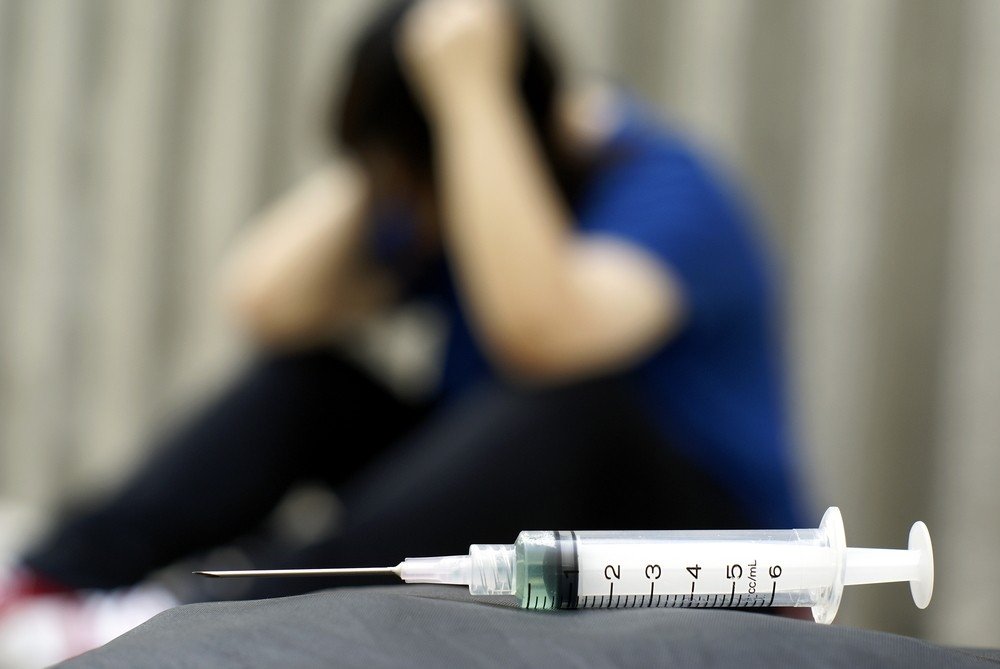
In Russia, a similar path of infection is found in most cases. Infection of people is carried out through the use of a common syringe without compliance with sterilization. Or the infection can be brought through the general solution, because blood may also get there. This is how they become infected in 30-35% of cases.
- Unprotected anal sex
Another penetration of the virus is possible with homosexual or heterosexual contacts. Even a single act may become decisive. Usually passive partners receive an infection more often, since the rectum is too sensitive and cracks can appear in it.
- Unprotected oral sex
For active partners, the risk of infection is practically absent, but passive, has a small risk. But, if there are sores or wounds on the mucous membrane, then the risk of infection is higher from this.
- Transfer from mother to child
When a woman is infected with HIV and gives birth to a child, he can also be infected. This happens directly during childbirth, when the baby is in contact with the particles of the placenta, as well as through breast milk. It also happens that women become infected from children. This is possible if the baby has damage to the mucous membrane of the mouth, and the woman has nipples.
- Random injuries in medical intervention, as well as from injection
In this case, the probability of infection is up to 1%. But here we must understand that contact with potentially dangerous human liquids is needed. Otherwise, infection is impossible.
- Blood transfusion, organs transplant
In such a situation, infection cannot be avoided. It manifests itself in 100% of cases. It is believed that the stronger the immunity of a person, the less the risk of infection and vice versa. But here we must take into account a few points. If the patient takes therapy, then his viral load decreases greatly, and therefore he himself becomes less dangerous as a carrier. If any treatment is absent, then, of course, the danger becomes much higher.
Signs of HIV infection in men and women: Stages
Before considering the first signs of HIV, you must learn one thing - instantly the infection never manifests itself. Moreover, no modern analysis is able to detect it immediately. Usually HIV is found in later stages. When an infection penetrates into the body, its distribution begins and it develops in several stages:
- The very first - This is the incubation period when viruses only enter the body and settle in it.
- The next stage - This is an acute infection, when the temperature rises slightly, but it rests constantly, the lymph nodes increase and the tonsillitis can often be repeated.
- The third stage - Asymptomatic. Any symptoms cease to manifest itself and the need to see a doctor disappears.
- The fourth stage It is manifested by lesions of organs, mucous membranes and the body as a whole. Therapy during this period is still effective. It is also called secondary manifestations.
- Last, fifth stage - Terminal, when therapy is not too effective, although life can extend the patient.

As statistics are shown, HIV is often found at the penultimate stage and this is due to the fact that until this moment the symptoms are blurry. Although, at the very beginning they are also there, but they proceed easily and no one even thinks that the situation may be very serious.
Although, even if you come to the doctor, then he is unlikely to be able to detect an infection, because its diagnosis is so difficult. Moreover, the symptoms are often similar in men and women. Differences begin, again, only at the penultimate stage.
The first signs of HIV infection in men and women: when do they appear?
The first signs of HIV are always very blurry and precisely because even doctors cannot immediately determine the presence of an infection in the body. Despite this, the very first symptoms appear after 3 months, and maybe earlier. Late manifestations are also possible, but this is if the patient’s immunity is extremely strong and is able to restrain the infection for a long time. At the same time, the danger to others is not a fact that no one was infected.
Secondary manifestations can also appear in different ways. Again, the whole thing is in immunity, which can be struck by the first stages or remain at the same level. In any case, someone has an account for months, and for someone for years.
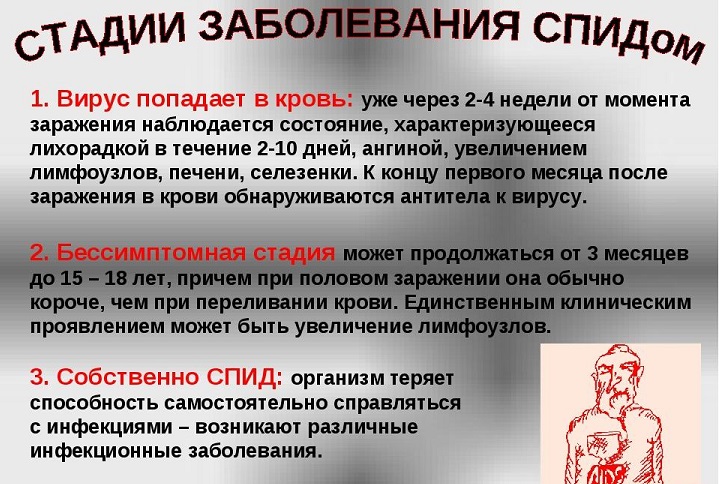
The first signs of HIV infection in men and women in the incubation period
When the virus enters the body, the first signs of HIV do not appear. It turns out that from the very first days and even weeks, it is impossible to talk about pathology. This period is considered incubation. Its duration is up to three months.
Even if at this time you began to suspect that not everything is in order and take the tests, they will not find anything. And your condition will not change. Remember that this period is especially dangerous in the sense that, although a person does not know about infection, he is able to infect another.
After the completion of this stage, the second one comes into business - an acute infection, when it seems to be HIV and can be established, but it is still in question.

The first signs of HIV infection in men and women in acute stage
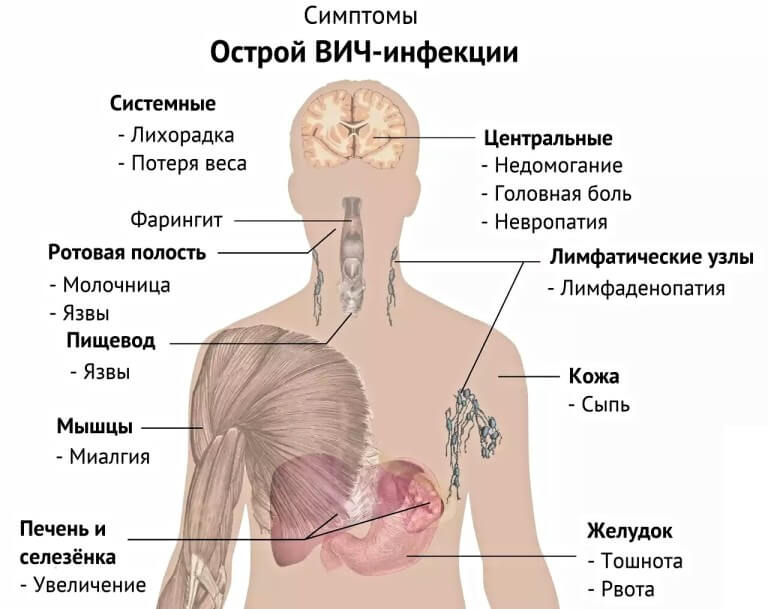
The beginning of the acute phase is more like mononucleosis. It manifests itself from the third week to three months from the moment of infection. As a rule, the first signs of HIV are manifested as follows:
- Tonsillitis. Often, patients begin to constantly get sick with sore throat
- Inflammation of the lymph nodes. This is one of the first systems that HIV affects. It seems that they become more in size, but at the same time pathology is not found
- Body temperature rises and does not decrease even when using special means
- At night, the patient suffers from severe sweating, he can sleep poorly and experience weakness. By the way, such signs are also for chronic fatigue
- The appetite is still lost, headaches and apathy begin to everything that happens around
- The doctor may notice that the spleen and the liver are slightly increased in size. The patient, by the way, in the field of the latter may occur periodic pains. The skin can be covered with a rash without certain boundaries.
- It happens that patients show prolonged diarrhea, which also does not disappear if you change the diet or use the means to fix the stool.
- It is possible to understand that some pathology is developing in the body due to a blood test. Typically, in it the number of lymphocytes and leukocytes is reduced, and mononuclear cells of the atypical appearance appear.
- These symptoms are manifested in most people. In 30-40% of patients, serous type meningitis or even encephalitis develops. In these cases, the symptoms are very different in nausea, vomiting and too high temperature.
- Often the initial Symptom of HIV is esophagitis - this is inflammation in the esophagus, when it is very painful to swallow and hurt in the chest.
It is important to say that regardless of manifestations, in a month or two they disappear completely, as if a person is healthy.
The first signs of HIV infection in men and women: asymptomatic stage
This stage was therefore called asymptomatic, since there are no signs of infection at all. The patient feels perfectly and does not even think that he needs to be urgently examined. Although, in the blood, the infection can already be detected. If the pathology is detected precisely at this stage, then the development of concomitant diseases can be prevented, because treatment will be prescribed on time.
The duration of the stage is determined individually. This is largely due to the fact that each immunity is different. Someone in a month will begin to notice the first signs of HIV, and someone will pass several years before, something will become noticeable. Therefore, doctors always follow themselves carefully and take such tests at least once a year.
The first signs of HIV infection in men and women: generalized lymphadenopathy
When the next stage occurs, almost all lymph nodes increase. Only inguinal do not suffer. By the way, it is for now that the first signs of HIV appear that can talk about infection, but not for sure. Again, a special test will show a positive result.
A feature of this stage is that despite a significant increase in the lymph nodes, up to 5 cm, they remain mobile and if they touch them, it will not hurt. The surface of the skin itself also does not change in any way, and therefore usually does not speak of the development of pathology.
Here, too, there is a certain danger, since such a strong increase is not observed with any disease, and therefore the doctor can calculate lymphadenopathy is difficult to explain. This stage lasts about three months, but after two patients begins to quickly lose weight.
The first signs of HIV infection in men and women: stage of secondary manifestations 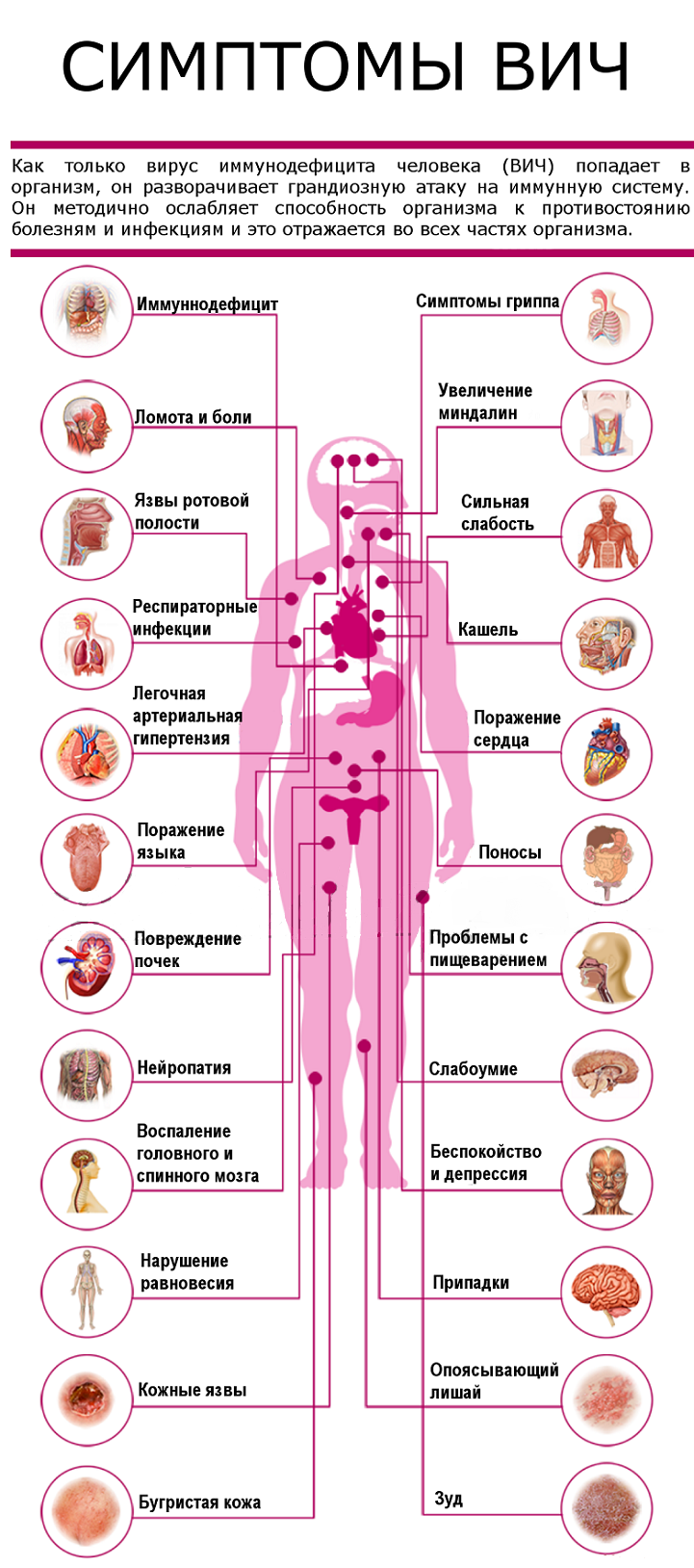
At this stage, a person’s health is already very deteriorating and we can say that the first signs of HIV appeared, which are obvious and already somewhat specific. When one of the diseases is manifested, a full examination is carried out and the stage of infection and the degree of damage to the body are determined by its results. It is characterized by the following symptoms:
- Pneumonia of a pneumocytic nature
The patient begins pneumonia and it seems to be nothing unusual in it. Like everyone - high temperature, shortness of breath, chest pain. But the treatment in this case is not very effective, since the body's resistance becomes low and immunity does not cope with its work.
- Generalized infection
This includes any manifestations of herpes, tuberculosis, candidiasis and cytomegalovirus infection. They are characteristic of women. The course is observed very severe and ordinary treatment is also ineffective.
- Sarcoma Kaposhi
These are small tumors that are in the lymph vessels. They are mainly diagnosed in men. Bright red tumors are located throughout the body and pain is felt on palpation.
- Defeat of the central nervous system
If HIV affects the nervous system, then problems with the memorization of information begins, it is difficult to focus on some matters. Without treatment, this situation can lead to dementia.
How are the first signs of HIV infection in women?
Women infected with HIV for the most part suffer from generalized infections expressed in candidiasis, Teberculsis and others. By the way, often the first signs of HIV at the penultimate stage begin with the fact that menstruation is going on failures, and inflammation in the pelvic organs may also begin. In rare cases, pathologies begin, but they may indicate the presence of infection in the body.
How are the first signs of HIV infection in children?
The infection is usually not transmitted to children from strangers. They are infected in the womb or through breast milk. It turns out that the mother is capable of infecting the baby. The disease occurs in children not as in adults. To begin with, it is important to note that the first signs of HIV do not appear immediately, but only after a few months. In addition, the defeat of the central nervous system can be considered an early sign when the child’s development is strongly inhibited.
Moreover, the child’s digestive system is in great danger, since it is it that is subject to strong changes that are constantly progressing. In addition, purulent diseases often appear.
How are the first early signs of HIV infection in men?
As for men, their first signs of HIV are usually not very specific. Although, such a sarcoma of Kaposhi can become. It is characterized by the appearance of tumors in the lymph nodes throughout the body.
Why is it so important to identify the first signs of HIV infection?
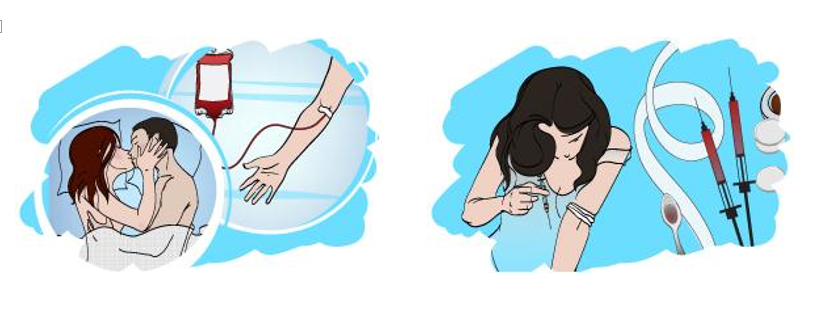
It is very important to identify the first signs of HIV even at the stage when the internal organs are not affected and there are no pathological changes in them. Regardless of the stage, doctors prescribe therapy, but it is most effective precisely with initial manifestations.
When the last stage of HIV comes - terminal, AIDS is already developing. Diagnosis of the disease at this stage can be clearly. The stage is dangerous in that with its development, the body already receives irreversible changes and all therapy, although it makes sense, but is not able to completely drown out the disease. It continues to develop, albeit slowly. If no action is taken, then in this case the patient will live no longer than three years.
AIDS affects all organs of the human body, but usually individual diseases are distinguished. They are in no way connected with each other. For example, pathological changes in the liver, and then in the lungs, may begin. It all starts unexpectedly and is never clear what will be the following. This is due to the fact that immunity can no longer fight even the simplest diseases and their treatment becomes difficult. The patient’s body is very depleted and it loses weight, experiences weakness and quickly tires.
AIDS can manifest itself in several forms that differ in symptoms:
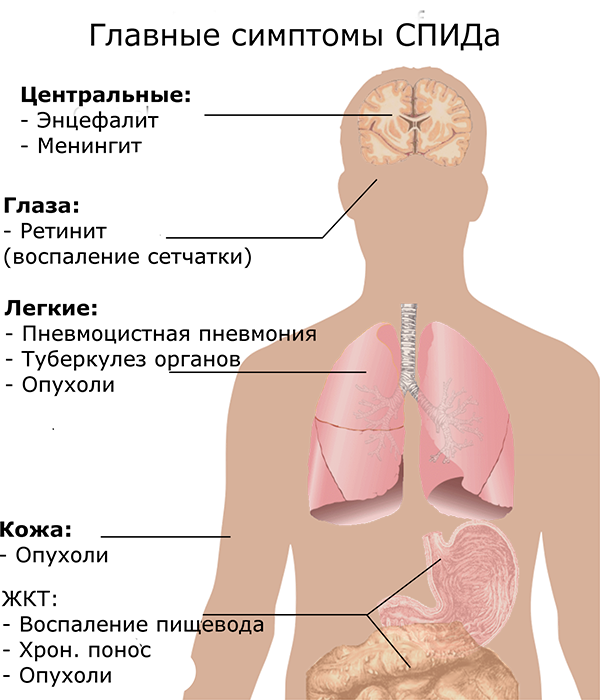
- Pulmonary. The lungs are affected. Often in patients, pneumonia with death develops. This is due to the fact that there is no longer any effect from antibiotics and antibacterial agents, even they do not help immunity to cope with the disease. This condition is characterized by shortness of breath and constant pain in the chest.
- Intestinal. A digestive system falls under the blow. She refuses to work normally and therefore the food ceases to digest. As a result, severe diarrhea develops. Bacteria, fungi and parasites are actively propagated in the intestine.
- Neurological. The central nervous system suffers. The patient may stop speaking, dementia is actively developing and he even ceases to control natural processes. Hemorrhage in the brain may occur. Moreover, tumors of different nature, meningitis or abscesses can form in it.
- Common. In this case, damage to the body is total. A variety of diseases occur, but vision suffers most, and renal failure develops. Often, the refusal of the kidneys leads to death. Explicit symptoms of this form are also damage to the skin. These are various dermatitis, fungi, lichen, damage damage and so on. That is, with the development of this form, all systems and organs are affected, especially if a person has been infected for several years.
By the way, the risk of infection during this period is minimal, because a person is already aware of the seriousness of the situation and the fact that he is dangerous to others. And in itself the appearance of a patient of HIV at the last stage already says a lot.
The human immunodeficiency virus to this day is not fully studied. He can behave unexpectedly and even doctors in diagnostics have many questions. Doctors claim that only patients themselves can recognize the presence of a disease at an early stage. Therefore, it is so important to monitor your health and undergo an examination at least once a year. Even if there are no symptoms, the disease can develop hidden. Only on time the tests taken can help extend life and avoid serious consequences.
Video: Penza reminded the main symptoms of HIV







